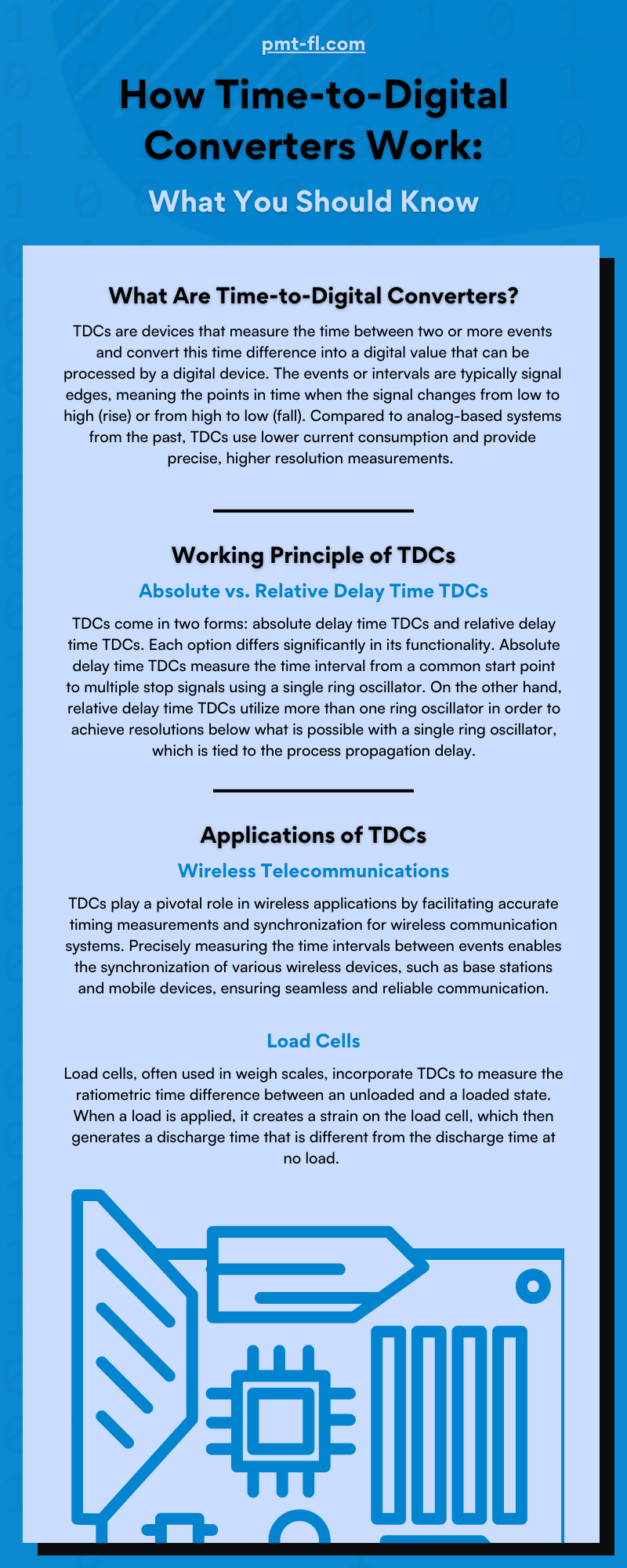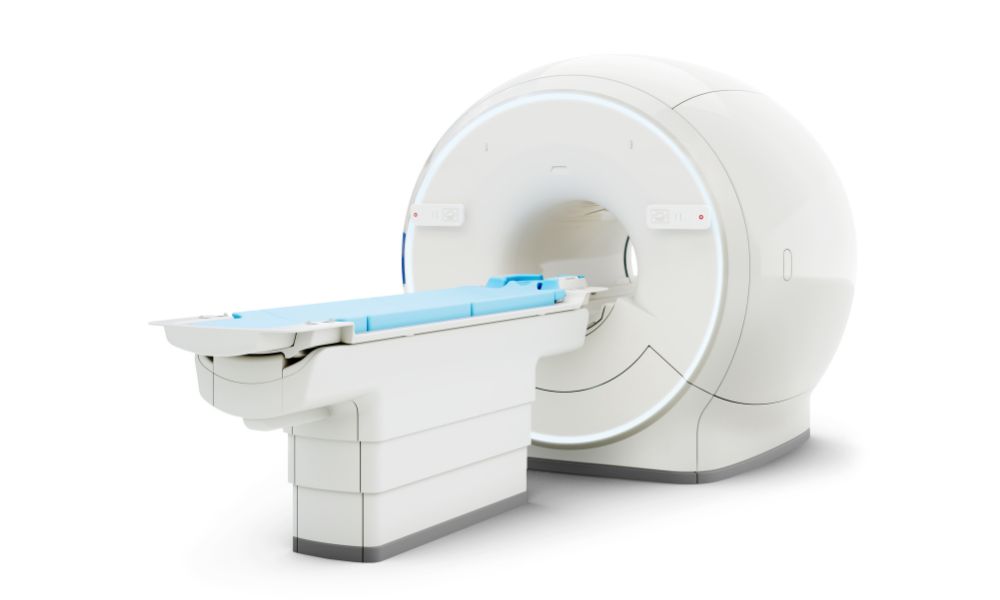Time-to-digital converters (TDCs) are some of the fundamental building blocks in digital electronics. These high-tech converters essentially translate time intervals into digital values, offering many applications and benefits. Learn everything you should know about how time-to-digital converters work and discover how you can maximize your products with TDCs.
What Are Time-to-Digital Converters?
TDCs are devices that measure the time between two or more events and convert this time difference into a digital value that can be processed by a digital device. The events or intervals are typically signal edges, meaning the points in time when the signal changes from low to high (rise) or from high to low (fall). Compared to analog-based systems from the past, TDCs use lower current consumption and provide precise, higher resolution measurements.
Working Principle of TDCs
TDCs work by starting a counter at the first event and stopping the counter at the second, measuring intervals as small as a nanosecond down to the picosecond range. The counter value then represents the time interval between each signal edge.
Absolute vs. Relative Delay Time TDCs
TDCs come in two forms: absolute delay time TDCs and relative delay time TDCs. Each option differs significantly in its functionality. Absolute delay time TDCs measure the time interval from a common start point to multiple stop signals using a single ring oscillator. The resolution of this type of TDC depends on the propagation delay of the process used to fabricate the chip. The stop signals determine the number of ring oscillator cycles in the measured time intervals and provide you with precise measurements to the resolution of the semiconductor process.
On the other hand, relative delay time TDCs utilize more than one ring oscillator in order to achieve resolutions below what is possible with a single ring oscillator, which is tied to the process propagation delay. With this method, the two or more ring oscillators are offset to greatly improve resolution.
Applications of TDCs
Consider the following applications of time-to-digital converters.
Wireless Telecommunications
TDCs play a pivotal role in wireless applications by facilitating accurate timing measurements and synchronization for wireless communication systems. Precisely measuring the time intervals between events enables the synchronization of various wireless devices, such as base stations and mobile devices, ensuring seamless and reliable communication. Synchronization is crucial for maintaining efficient data transmission, reducing interference, and optimizing overall system performance in wireless telecommunications.
Load Cells
Load cells, often used in weigh scales, incorporate TDCs to measure the ratiometric time difference between an unloaded and a loaded state. When a load is applied, it creates a strain on the load cell, which then generates a discharge time that is different from the discharge time at no load. With the ratio of no load to load discharge times, the precise weight is easily calculated by the chip. The collected data can be further processed for display or for communication with other digital systems. The high precision of TDCs ensures the accuracy of load measurements, making them indispensable in applications where precise weight readings are essential. Scales using a TDC solution can also meet the NTEP and OIML standards.
Capacitance Measurements
In the field of electronics, capacitance measurements are vital. The capacitance of a capacitor is determined by measuring the time it takes for the capacitor to discharge between two voltage levels, from fully charged to discharged. TDCs achieve higher precision by measuring in the time domain, instead of the analog domain, using a ratiometric method of a known reference capacitance value to the unknown capacitance. This ratio is then converted to a digital capacitance measurement with up to 22 bits of resolution. Using TDCs for capacitance measurement allows for high precision measurements while still achieving ultra-low power consumption.
High-Energy Physics
TDCs are used in a variety of high-energy physics applications to determine the exact time of arrival of an event at a detector. In addition, by using a delay line detector, the exact position of the arrival can be determined. This works with a variety of detectors available for high-energy physics.
This method is common in mass spectrometry, where TDCs are used to determine the chemical composition of a sample of material being tested.
Medical Technology
TDCs also find use in medical technology, particularly in positron emission tomography (PET) scanners. These advanced devices utilize TDCs to precisely measure the time difference between the detection of two positron particles. TDCs facilitate the creation of detailed images of organs and tissues within the human body. This capability allows medical professionals to diagnose and monitor various conditions, enabling effective treatment and care for patients. The utilization of TDCs in PET scanners enhances the accuracy and reliability of medical imaging, revolutionizing the field of medical diagnostics.
Liquid and Gas Flow Measurement
TDCs can be used to accurately measure the flow of liquids and gasses by measuring the difference in time of an ultrasonic pulse burst going in the same direction as the flow to the time of the ultrasonic pulse burst going against the flow of the liquid or gas. This measurement method yields very high precision measurements with liquid flows of less than 0.5 liters per hour (8 milliliters per minute). This makes TDCs perfect for residential water meters up to large diameter meters, chemical mixing, airflow, and gas flow.
LiDAR and Rangefinders
TDCs are found in military and commercial LiDARs and rangefinders that are used for avoiding collisions and determining distance. TDCs are also used in LiDAR mapping systems. In this application, the laser firing triggers the start of the measurement, and the laser light bouncing back from the target stops the measurement. The resulting time-of-flight measurement is then converted to the distance measurement of how far away the target is from the LiDAR rangefinder.
Advancements in TDC Technology
With advancements in technology, TDCs have evolved significantly. Today’s TDCs can achieve resolutions in the picosecond range and offer many more benefits than ever before.
Ring Oscillators
Ring oscillators are crucial components in TDCs—they are electrical circuits designed to generate continuous oscillating digital signals. The frequency of these oscillations is determined by the propagation delay through inverters. The ring oscillator propagates a forced start through its odd number of inverters. At the end of the cycle of inverters, the oscillator will increment the TDC’s coarse counter and loop back to the beginning of the cycle.
When a stop comes through to the circuit, the oscillator latches the state of each inverter and the coarse counter in dynamic memory. Inverters with the same input and output indicate the inverter hasn’t switched yet (started a new cycle), giving you precise information on where you are in the time count. TDCs use ring oscillators to achieve precise time resolutions in the 10-picosecond range.
Multi-Hit Capabilities
An important advancement in TDC technology is the development of multi-hit capabilities. This feature allows TDCs to record multiple events within a single measurement window, significantly enhancing their functionality. In traditional TDCs, only the time interval between two events is measured. However, multi-hit TDCs enable the registration of multiple time stamps independently during a single measurement cycle, offering value in high-energy physics and LiDAR technology where rapid sequences of events occur. The multi-hit capability of modern TDCs expands their applications and enhances precision.
Single-Chip Solutions
Early TDC designs consisted of large and expensive circuit boards. Now, modern TDC designs are compact single-chip solutions. These compact TDC systems offer benefits such as reduced size, lower power consumption, and increased reliability. By optimizing the design and integrating all the necessary components into one chip, single-chip TDCs provide enhanced performance and time resolution, as well as broader application possibilities.
At Precision Measurement Technologies, we distribute and provide technical support for single-chip ScioSense time-to-digital converters. These chips include maximized properties and functionalities, like low current consumption and high resolution in a compact design—the perfect measurement solution for an array of products.
Learning all you need to know about the workings of TDCs is crucial, given their wide-ranging applications in various fields, from medicine to telecommunications. Give PMT a call today to find the perfect TDC for your product and to receive additional support.


